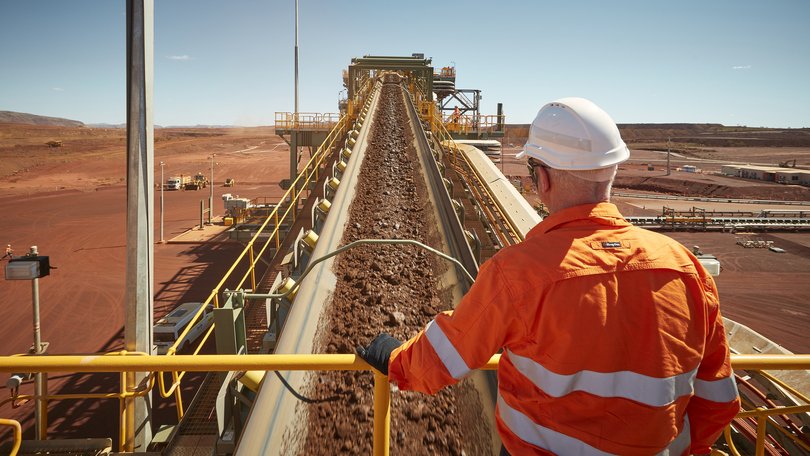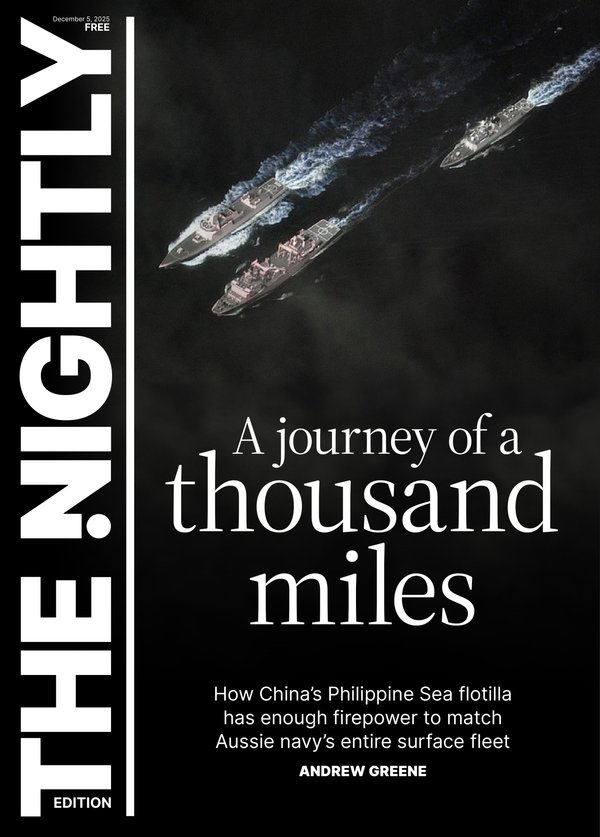Confusion reigns amid BHP price talks with China while reports of iron ore ban swirl

The price of iron ore has slipped as traders keep watch on BHP amid a stand-off that reportedly threatens to halt the flow of the steel-making ingredient from the Big Australian’s powerhouse Pilbara mines into China.
The world’s biggest miner was on Wednesday continuing to negotiate a deal with the Middle Kingdom as Prime Minister Anthony Albanese calling the rumoured stalemate “concerning”.
China’s state iron ore buyer reportedly ordered steelmakers and traders to pause purchases of US dollar-denominated seaborne iron ore cargoes from the Big Australian during its annual price negotiations, sources said on Tuesday.
Sign up to The Nightly's newsletters.
Get the first look at the digital newspaper, curated daily stories and breaking headlines delivered to your inbox.
By continuing you agree to our Terms and Privacy Policy.That report from Bloomberg was contradicted by steel market analytics firm Mysteel later that evening, which said it had verified the rumours were not true and no such order had been made.
Iron ore futures in Singapore had fallen 0.4 per cent to $US103.10 a tonne by early Wednesday afternoon after rising as much as 1.7 per cent on Tuesday,
Sources on Wednesday morning said BHP cargoes were continuing into China as commercial talks progressed.
Even so, the miner’s stock faced a rocky start to trading amid the conflicting reports. It was was down 1.3 per cent to $41.99 but 11.30am.
Mr Albanese said he was concerned about reports of a possible ban, noting that China had made similar moves in the past.
He said the Government wanted to ensure “markets operate properly” around the world.
“I want to see Australian iron ore be able to be exported into China without hindrance,” he told reporters on Wednesday morning.
“That is important.
“These measures are always disappointing, but let’s hope certainly that they are very much short term.
“Sometimes when people are negotiating over price, sometimes these things will occur, but I want to see this resolved quickly.”
It was reported late on Tuesday that the decision to halt purchases of BHP ore followed several meetings between the two sides since late last week that had failed to produce results.
China, the world’s largest iron ore consumer, buys about 75 per cent of global seaborne iron ore and established China Mineral Resources Group three years ago to buy ore on behalf of its steelmakers in a bid to gain more leverage as a large, single buyer and keep a lid on prices.
The Middle Kingdom has grown more willing to leverage its clout in raw materials markets in recent times, including bans on Australian commodities earlier this decade as well as export controls on rare earths this year.
The move also highlights Beijing’s determination to gain greater influence over prices and also risks upending one of BHP’s most important trading partnerships.
The stalemate has prompted Treasurer Jim Chalmers to seek a conversation with BHP chief executive Mike Henry.
He also described talks of a ban as “concerning” but said “ultimately, though, they are about the commercial arrangements between two companies”, according to The Australian.
“I’ll have discussions with Mike Henry about that in due course, when we can set that up,” Dr Chalmers said.
“More broadly, this is a government that advocates for Australia’s interests on the world stage with our major trading partners.
“You can expect that to be the case again – work through these issues calmly and carefully, advocating for the workers and businesses and investors of our country.”
BHP is China’s third-biggest supplier of iron ore behind Rio Tinto and Vale.
CMRG did not respond to requests for comment and a BHP spokeswoman on Wednesday morning said she could not comment on the negotiations.
MySteel’s report on “clarification regarding the rumour of ban on purchasing BHP iron ore” noted that “some foreign media outlets reported that the China Iron and Steel Association held a meeting and reached an agreement that China would ban the purchase of BHP iron ore, which drew widespread market attention”.
“Mysteel has verified through relevant channels and confirmed that this rumour is not true. Chinese steel mills have not received any such notice, and the information did not originate from the China Iron and Steel Association,” it said.
BHP has issued no new statements to investors via the Australian Securities Exchange to clarify the conflicting reports.
In a client note, Morgan Stanley said that given the size of BHP’s exports and the importance of China as a seaborne iron ore buyer, “we think both parties are likely to be equally motivated to resolve the dispute”.
RBC analysts called it a “neutral event”.
“We view this ‘ban’ as more of a negotiating tactic, most likely an effort to secure lower long-term prices,” they said.
If steel mills were pushed to buy iron ore from rivals such as Rio Tinto, Vale or Andrew Forrest’s Fortescue, cumulatively, it would cost them more and be less efficient, RBC said, adding that it would also be likely to increase miners’ pricing power as steel mills compete for feedstock.
A trading source said any such directive would cause little inconvenience to Chinese mills in the short term because they have already stocked up for the next two weeks ahead of looming public holidays.
BHP said in August that it would cut exploration spending after annual profit fell to its lowest in five years as slowing Chinese demand weighed on iron ore prices.
Iron strength
Despite widespread prediction of an iron ore fall below the milestone $US100/t mark, the price of the steel-making ingredient is defying the naysayers.
Market gurus last month again predicted a gloomy future for the commodity. Analysts from Australia’s big four banks had broadly predicted a tonne of iron ore would be worth less than $US90 by the end of this year.
The price flirted with the $US90/t barrier, falling to about $US92/t in June, but it rebounded after China’s leaders introduced new stimulus measures to boost the country’s ailing property sector.
A trade war between the US and China has also been less ferocious than many had feared, providing another tailwind for iron ore in recent weeks.
Beijing in August ordered some of the nation’s steel mills to cut production, which was expected to drag iron ore prices down.
RBC Capital Markets said two week ago it was “somewhat confusing” that demand for the commodity had held up.
The global investment bank upped its price forecast for the end of September by 3 per cent to $US100/t, but retained a bearish outlook beyond 2025. It has pencilled in a $US98/t price for the start of next year.
“We continue to see iron ore headwinds through 2026 . . . we maintain our 2027 to 2029 prices and make no change to long-term forecasts for iron ore of $US75/t,” it said.
Morgan Stanley is more bullish than most of its peers, predicting a $US100/t price by year’s end versus the consensus of $US95.50/t.
But it too believes upside “may be challenging” in the long-term unless China significantly ratchets up economic stimulus.
Originally published as Confusion reigns amid BHP price talks with China while reports of iron ore ban swirl
